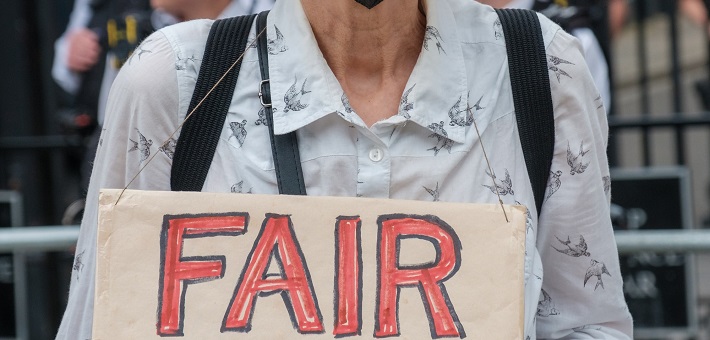Commentary on Jeremiah 31:27-34
The diversity of the book of Jeremiah means that readers will also find passages focused on reconciliation. Relative to the harsh judgment speeches, the softer tones of reconciliation are fewer. They, however, demonstrate that reconciliation between God and God’s people is critical for a reimagined future. In this future, the restored relationship contains new features that require a different perspective upon God.
The lection opens with an unmistakable eschatological note. The phrase, “the days are surely coming” not only positions the reader to the future but a future with cataclysmic changes that may involve destruction. In fact, 31:27 on its own reverberates with an ominous tone. Humans and animals as seed for the house of Israel and Judah could point to the loss of life that sustains Israel and Judah. On the other hand, the seed planting could portend a future of growth rather than destruction. The wider literary context means reading verse 27 in a positive light.
The reappropriated and recast prophetic vocation from 1:10 in 31:28 maintains the former ambiguity to anticipate both destruction and growth. Noticeably different in this passage is the addition of the phrase “and to cause evil” (ûlehārēae 31:28) to the list of functions that retains the divine right to destroy, if necessary. Further, moving the threatening surveillance function of 1:10 to frame the restated vocation list: “just as I watched them” (kaʾašer šāqaḏtı̂ ealêhem) so “I will watch them” (kēn ʾešqōḏ ealêhem) adds suspense to these verses because things don’t feel quite different. The ambiguity of the Hebrew word for “watch” (sqd) sets the tone of nurturing attention mixed in with menacing intent. The bright future notwithstanding, past experiences will not be forgotten.
The memory of the past and the tug of the future shapes critical moments in the lection. Another eschatological marker appears at the start of 31:29. This verse imagines a future where generational guilt is relieved. To do so, the verse engages what appears as a proverbial saying. Certainly, Ezekiel 18:2 explicitly cites it as a proverb. The sentiments, though, are consistent with Deuteronomy 5:9 as well as other citations, for example, Exodus 20:5 and Numbers 14:18. Unlike the passage in Ezekiel, Jeremiah appears to anticipate that punishment will fall to the current generation rather than carry over to successive generations. The tendency to interpret the verse as individual responsibility plays too much into modern individualistic culture. Everyone still shares the guilt of the community. Preachers will need to imagine a broader conception of sin to embrace how systemic failures infect the whole community. The difference that 31:30 points to means that the guilt will not continue to burden subsequent generations indefinitely. Paying attention to trauma studies raises the matter of intergenerational guilt. Trauma does not stop at a designated year in response to a scripture verse. Unresolved trauma continues to pass from one generation to the next and therefore requires concerted efforts to make meaningful changes. More than simply a call to stop using a proverb, 31:29-30 challenges hearers to the hard tasks to interrupt traumas and systems that too easily socialize new generations into dysfunction.
The third major section of the lection repeats the opening eschatological marker. The imagined future introduced at 31:31 focuses on the covenant relationship. Preachers can make much of what remains unsaid about the past covenant in this passage. The insistence that this covenant will not be like the past offers little as to what will be left out of the future arrangement. Certainly, one of the ways to understand that previous covenant is the structure of blessings and curses as detailed in the book of Deuteronomy. There, the people are warned that failure to keep the covenant will result in punishments up to and including expulsion from the land (Deuteronomy 28:15-68). On the other hand, obedience to the covenant will yield prosperity in the land (Deuteronomy 28:1-14). Those features remain unstated here in Jeremiah. Does this mean that moving forward punishment no longer features in the divine relationship?
The logic of 31:32 that recounts the past may provide an answer to the question of punishment in the future. The verse mentions God’s gracious rescue from Egypt and the failures of the people. The relationship described in either marital or monarchal terms seems not to contain any consequences for the breaking of the covenant. The hierarchical power contained in the Hebrew word for husband or overload (bāealtı̂) suggests that such loss of honor should be avenged. The verse makes no mention of such consequences. Perhaps the consequences of failure remain too evident in the broken relationship that needs mending, such that repeating them may serve no good purpose. The silence speaks volumes. No doubt, the commitments that close 31:34 point in a strong direction to a reformed deity. How much preachers vocalize this silence depends upon whether they see God as restored from the past relationship marked by failure, where violence was a justified response. Certainly, interpretations that engage the growth of God through the experiences of rejection and loss offer preachers a chance to explore the complexities of relationships. The use of relational terms in the verse drawn from human experiences already helps preachers to think in these frames.
As 31:32 struggles to name what the future covenant is not, 31:33 offers to define it positively. There is more to work with here. The pedagogical strategy of the wisdom school provides the template for internalizing truth (see Proverbs 3:3; 7:3). Writing on the heart rather than on the implied stone tablets (see Ezekel 36:26) allows for the covenant to become part of the community’s mental and intellectual fabric. In the future, everyone becomes both teacher and learner. The distinctions of age, experience, wisdom, and knowledge will be removed since the community becomes oriented to this new relationship (31:34). If individuality is not imagined in 31:29-30, so too here the emphasis lies on community. The flattened hierarchies mean that everyone is responsible for the well-being of the community. The room for self-righteousness through finger pointing gives way to the neighborly embrace of mutual support and co-learning.
As seen before, the gestures to the future retain features of the past. The reductive formula in 31:33, “I will be their God, and they shall be my people” combines assertions found in Genesis 17:8 and Exodus 29:45, “I will be their God” with the invitation to relationship, “they shall be my people.” This formula suggests mutuality implied in the presentation of the covenant as a mental assent to divine teachings. To take the covenant on the heart represents an act of willing acceptance of teachings rather than an imposition of a regulatory system. God invites people into this covenant relationship. As such there appears room to deal with the frailties of human weaknesses. God’s commitment in 31:34 to the forgiveness of sin and the clean slate marks a new phase in a relationship too often characterized in abusive categories. The real challenge that preachers face lies not so much in nailing down precisely the outlines of what the covenant looks like in Jeremiah. Rather, preachers need to offer pictures from these verses that free their hearers to embrace a relationship where their true selves matter. The outlines of this lection invite readers to imagine a God that no longer looks like the angry deity set upon punishment and destruction. Imagining a divine relationship that does not sanctify violence, but affirms self-negation, or leaves room for self-righteousness can be an exciting task for preachers.


October 16, 2022